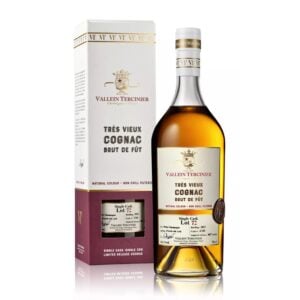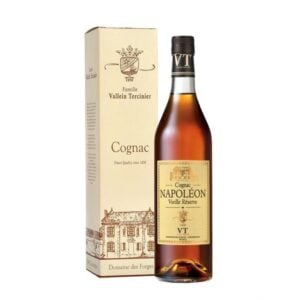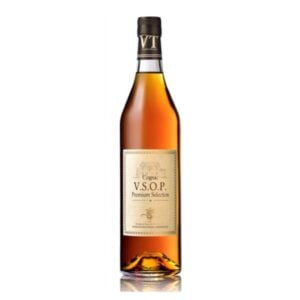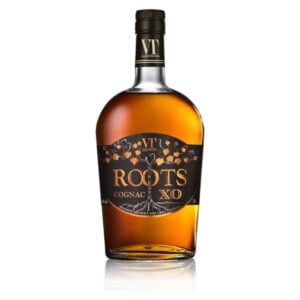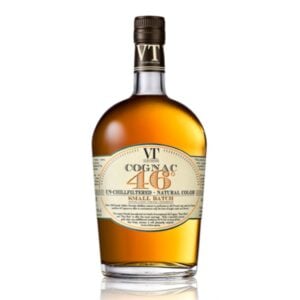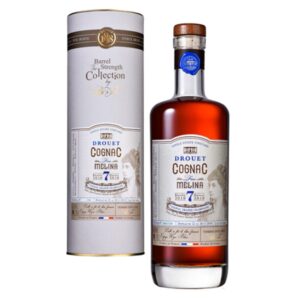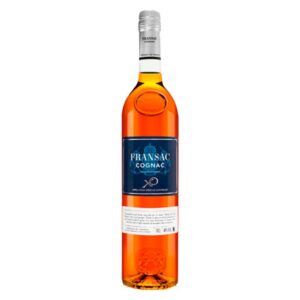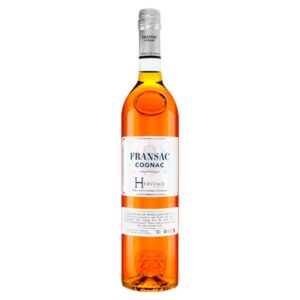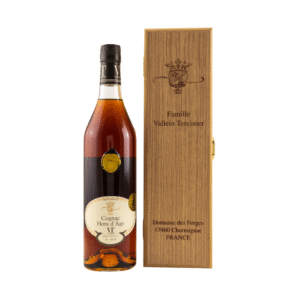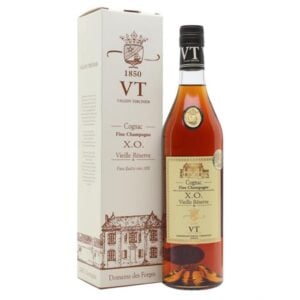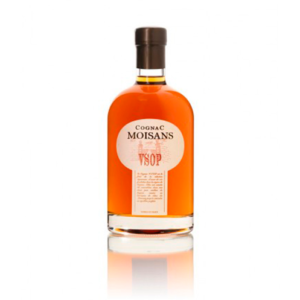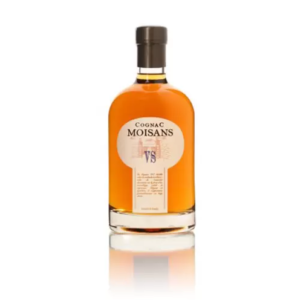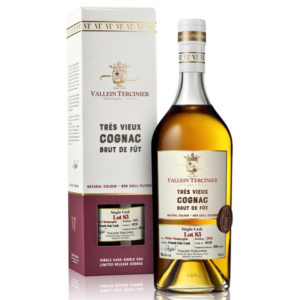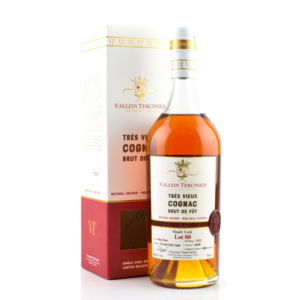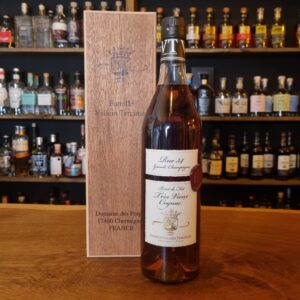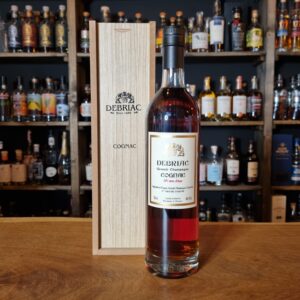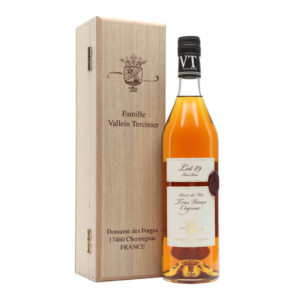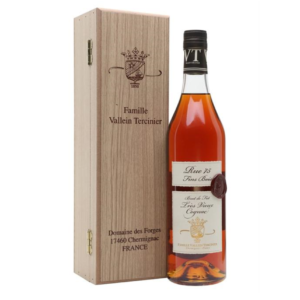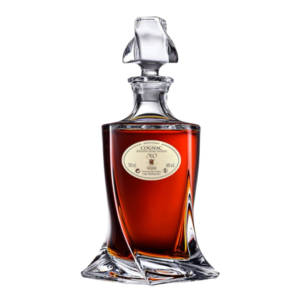Showing all 20 resultsSorted by popularity
Cognac – The Complete Guide
TL;DR: In Brief
- Cognac is characterized by its rich, complex flavor profile with notes of dried fruit, oak, vanilla, and spice
- Produced exclusively from white grapes (primarily Ugni Blanc) and defined by double distillation in copper pot stills
- Available in several age classifications, including VS, VSOP, XO, and beyond
- Best enjoyed in a tulip-shaped glass at room temperature and can be experienced in cocktails like the Sidecar or Vieux Carré
Disclaimer: This guide is intended for informational purposes for adults over 18 years of age. Vault of Spirits encourages responsible consumption of alcohol.
Introduction to Cognac
Cognac has a rich history and fascinating craftsmanship behind it. From its origins in the Charente region of France to its global popularity today, this spirit has evolved to become one of the world’s most cherished luxury drinks.
This guide provides insight into the production, flavor notes, and enjoyment of cognac, whether you’re a novice or experienced enthusiast.
With centuries of tradition and strict regulations ensuring its quality, cognac represents the pinnacle of the distiller’s art, offering complexity and refinement that few other spirits can match.
How Did Cognac Originate?
From Past to Present
Cognac’s story begins in the 16th century when Dutch merchants sought to trade for salt and wine from the Charente region of western France.
The white wines of the region were popular but didn’t travel well on long sea voyages. To solve this problem, the Dutch began distilling the wine to preserve it, creating “brandewijn” (burnt wine), the predecessor of brandy.
By the 17th century, the locals had refined the process, discovering that double distillation produced a superior spirit. They also found that aging the spirit in oak barrels dramatically improved its character, leading to the development of what we now know as cognac.
Which Historical Milestones Shaped Cognac?
The establishment of the first cognac houses in the early 18th century, including Martell (1715), Rémy Martin (1724), and Hennessy (1765), marked a turning point in cognac’s history.
The phylloxera crisis of the late 19th century devastated European vineyards, leading to the widespread adoption of American rootstock resistant to the pest. This dramatically changed the grape varieties used, with Ugni Blanc becoming the dominant grape.
The legal definition and protection of the Cognac appellation in 1909 ensured the spirit’s authenticity and quality, cementing its reputation as a premium product.
How Has Cognac Influenced Cultural Traditions?
Cognac has long been associated with luxury and refinement, becoming a status symbol among European aristocracy and later among the global elite.
In France, it traditionally marks significant moments in life – from births to business deals – often enjoyed as a digestif after meals.
In contemporary American culture, particularly in hip-hop and R&B, cognac gained prominence in the 1990s and 2000s, featuring in songs and videos and becoming synonymous with success and sophisticated taste.
Why Is Cognac Popular Today?
Cognac’s reputation for quality and luxury continues to drive its popularity in traditional markets like Europe and North America.
In emerging markets, particularly in Asia, cognac has become a prestigious gift and a symbol of status, with China now representing one of the largest markets for premium cognac.
The resurgence of classic cocktail culture has reintroduced cognac to a new generation of drinkers, who appreciate its complexity in mixed drinks.
The emphasis on craftsmanship, terroir, and tradition resonates with today’s consumers, who increasingly value authenticity and heritage in what they consume.
How Is Cognac Produced?
Which Raw Materials Are Used in Production?
Cognac begins with grapes, with strict regulations dictating which varieties can be used and where they can be grown.
Primary ingredients:
- Ugni Blanc (Trebbiano) – The dominant grape variety, valued for its high acidity and low alcohol content, making up about 98% of plantings
- Folle Blanche and Colombard – Traditional varieties still used in small amounts to add complexity
- Water – Used to reduce the alcohol content to bottling strength
The terroir of the Cognac region, with its chalky soil and moderate maritime climate, plays a crucial role in developing the grapes’ desired characteristics.
How Does the Fermentation Process Work?
After harvesting, the grapes are pressed and the juice ferments naturally for about 5-7 days, without adding sugar or sulfur.
Native yeasts convert the grape sugars into alcohol, producing a highly acidic white wine with 7-9% alcohol by volume.
This wine is deliberately acidic and not particularly pleasant to drink – it’s designed specifically for distillation, not consumption.
The fermentation must be completed by March 31st following the harvest, as regulated by law, to preserve the freshness and quality of the base wine.
Which Distillation Techniques Are Used?
Cognac’s distinctive character comes from its unique double distillation process, performed in traditional Charentais copper pot stills.
Common distillation methods:
- First Distillation (Brouillis) – Produces a liquid with 28-32% ABV, capturing essential flavors from the wine
- Second Distillation (Bonne Chauffe) – A meticulous process where the distiller separates the heads, hearts, and tails, keeping only the heart (middle portion) for aging
- Pot Still Distillation – The only legally permitted method, as column stills are prohibited for cognac production
Distillation must be completed by March 31st following the harvest, ensuring that only fresh wine is used in the process.
What Is the Significance of Aging?
Aging transforms the clear eau-de-vie into the amber-colored, complex spirit we recognize as cognac.
By law, cognac must age in oak barrels, traditionally made from trees from Limousin or Tronçais forests in France.
During aging, the spirit extracts compounds from the wood, gains complexity, develops color, and loses alcohol through evaporation (the “angels’ share”).
The master blender (Maître de Chai) monitors the aging process and eventually combines different eau-de-vie to create consistent house styles or special expressions.
Which Regions Are Known for Cognac?
Where Are the Best Varieties Produced?
Cognac can only be produced in a legally defined area surrounding the town of Cognac in the Charente and Charente-Maritime departments of France.
This area is divided into six growing regions (crus), each imparting distinct characteristics to the final product:
Grande Champagne: The premier cru, producing the finest, most delicate cognacs with the greatest aging potential.
Petite Champagne: Creates elegant cognacs similar to Grande Champagne but with slightly less finesse.
Borderies: The smallest region, known for producing rounder, more floral cognacs with violet and iris notes.
Fins Bois: Surrounds the first three regions, producing fruity cognacs that mature more quickly.
Bons Bois and Bois Ordinaires: The outer regions, producing simpler cognacs often used in younger blends.
How Do Geography and Climate Affect the Flavor?
The chalky soil of Grande and Petite Champagne regions contributes to the finesse and longevity of cognacs from these areas.
The maritime climate of the Cognac region provides mild winters and moderate summers, ideal for both grape growing and aging.
Humidity levels, particularly in coastal areas, affect the aging process, with higher humidity resulting in softer cognacs and lower alcohol reduction during aging.
The orientation of vineyards and their proximity to the Charente River can influence grape ripening and ultimately the character of the eau-de-vie.
What New Trends Are Seen in Cognac Production?
Single-estate cognacs are gaining popularity, with producers highlighting the terroir of specific vineyards rather than just blending across regions.
Experimental cask finishes, such as using barrels that previously held Sauternes, port, or even whiskey, are creating new flavor profiles while respecting tradition.
Organic and biodynamic viticulture is increasing, with some producers focusing on sustainable farming practices.
Limited edition releases and vintage-dated cognacs are appealing to collectors and connoisseurs looking for unique expressions.
What Do the Different Quality Designations Mean?
Cognac’s age classifications are based on the youngest eau-de-vie in the blend:
VS (Very Special): Aged at least two years in oak.
VSOP (Very Superior Old Pale): Aged at least four years in oak.
XO (Extra Old): Aged at least ten years in oak (increased from six years in 2018).
XXO (Extra Extra Old): A newer category requiring a minimum of 14 years of aging.
Hors d’âge, Napoléon, Extra, and other designations indicate premium cognacs, often aged significantly longer than the minimum requirements.
How Does Cognac Taste?
What Characterizes the Typical Flavor Profile?
Cognac offers a complex symphony of flavors that evolve from first nosing through to the finish.
Typical aromas:
- Fruit – Dried fruits like apricot, fig, and raisin, often with citrus notes in younger expressions
- Floral & Spice – Violet, rose, vanilla, cinnamon, and nutmeg, with more exotic spices in older cognacs
- Wood & Earth – Oak, leather, tobacco, chocolate, coffee, and sometimes truffle in well-aged expressions
The mouthfeel is typically smooth and warming, with a pleasant viscosity that coats the palate.
The finish can range from medium to extremely long in premium expressions, leaving lingering notes of spice, fruit, and oak.
How Does the Flavor Vary Between Different Styles?
VS cognacs tend to be vibrant and fruit-forward, with pronounced grape character and lighter oak influence.
VSOP expressions show more balance between fruit and oak, with emerging spice notes and a smoother texture.
XO and beyond develop profound complexity, with diminished fresh fruit giving way to dried fruits, deeper spice notes, nuttiness, and tertiary aromas like leather and tobacco.
Regional differences are noticeable to experienced tasters: Grande Champagne cognacs show remarkable finesse and length, while Borderies cognacs exhibit distinctive floral notes.
How Does the Flavor Evolve with Age?
Young cognac is characterized by fresh grape notes, light floral aromas, and pronounced vitality.
As cognac ages, it gains complexity and depth, with fresh fruit evolving into dried fruit character and more pronounced spice notes.
After decades in oak, cognac develops what the French call “rancio” – a desirable character with notes of mushroom, walnut, cigar box, and old leather.
The texture also transforms with age, becoming progressively silkier and more integrated as the alcohol mellows and harmonizes with the flavor compounds.
What Signs Reveal High Quality?
Superior cognac displays balance and harmony between fruit, spice, and wood elements, with no single component overwhelming the others.
Length of finish is a key indicator – premium cognacs leave a lingering, evolving finish that can last for minutes.
Complexity is crucial – the best cognacs reveal different notes with each sip and continue to evolve in the glass.
Texture should be smooth and velvety, without harsh alcoholic heat, even in younger expressions.
How Is Cognac Best Enjoyed?
What Is the Optimal Serving Method?
Traditionally, cognac is served neat to fully appreciate its complex character.
While purists might disagree, adding a small splash of still water can help open up the aromas and flavors, especially in higher-proof expressions.
Many experts recommend avoiding ice, as the cold temperature can mute the delicate aromas, though a large, slow-melting ice cube can be acceptable for younger cognacs in warm weather.
Before drinking, take time to appreciate the color and nose, as these are integral parts of the cognac experience.
Which Glass and Temperature Are Ideal?
A tulip-shaped glass is ideal for cognac, as it concentrates the aromas at the narrower rim while allowing room for the spirit to breathe.
The traditional balloon snifter can work well but sometimes concentrates alcohol vapors too intensely.
Room temperature (around 18-20°C or 64-68°F) is optimal for serving fine cognac, allowing all aromatics to express themselves fully.
Warm the glass gently in your hands to release more volatile compounds and enhance the aromatic experience.
How Do You Taste Like an Expert?
Observe the color, which can range from pale gold to deep amber, indicating age and cask influence.
Nose the cognac multiple times: first from a distance, then closer to the rim, noting how the aromas evolve.
Take a small sip and let it coat your entire palate, noting the initial flavors, mid-palate development, and finish.
Consider the cognac’s balance, complexity, intensity, and length – the four primary criteria used by professional tasters.
Which Dishes Complement Cognac?
Dark chocolate with high cocoa content pairs beautifully with aged cognac, complementing its fruit and spice notes.
Cheese, particularly aged Comté or blue cheeses like Roquefort, creates an interesting contrast with cognac’s richness.
Coffee-based desserts enhance the roasted notes found in well-aged expressions.
For a traditional French pairing, try cognac with foie gras or as a digestif following a rich meal.
Which Cocktails Can Be Made with Cognac?
Which Classic Cocktails Should You Know?
Sidecar
Ingredients: 2 oz cognac, 1 oz Cointreau, 3/4 oz fresh lemon juice, sugar rim
Preparation: Shake ingredients with ice, strain into a sugar-rimmed cocktail glass
History: Created during World War I, likely at the Ritz Hotel in Paris or Harry’s New York Bar
French 75
Ingredients: 1 oz cognac, 1/2 oz lemon juice, 1/2 oz simple syrup, champagne
Preparation: Shake cognac, lemon, and syrup with ice, strain into a flute, top with champagne
History: Originally made with gin, the cognac version is considered by many to be superior
Which Modern Cocktails Are Worth Trying?
Vieux Carré
A complex New Orleans classic combining cognac, rye whiskey, sweet vermouth, Benedictine, and bitters for a sophisticated sipper.
Paper Plane
A modern classic substituting cognac for bourbon in equal parts with Aperol, Amaro Nonino, and lemon juice.
Cognac Old Fashioned
A twist on the whiskey classic using cognac, sugar, bitters, and orange peel for a refined take on a timeless cocktail.
How Is Cognac Enjoyed Neat?
For contemplative sipping, pour about 30ml (1 oz) of cognac into a tulip glass and allow it to breathe for a few minutes.
In colder months, you can gently warm the glass in your hands to release more aromatics.
Some enjoy cognac with a side of room-temperature still water, taking small sips of water between tastes of cognac to refresh the palate.
For a traditional French experience, try dunking a sugar cube into your cognac and then enjoying both the sweetened cognac and the sugar cube.
Which Homemade Variants Can You Experiment With?
Cognac infusions with vanilla beans, cinnamon sticks, or dried fruits can create interesting variations for home enjoyment or cocktails.
Homemade winter warmer: Gently heat cognac with honey, lemon, and spices for a sophisticated hot toddy variation.
Create your own house blend by carefully mixing different cognacs to achieve your preferred flavor profile.
Explore homemade cocktail bitters using cognac as the base spirit, adding botanical elements like orange peel, gentian root, and aromatic spices.
What Should You Know Before Buying Cognac?
Which Details Should You Pay Attention to When Buying?
Age classifications (VS, VSOP, XO) indicate minimum aging requirements, but many cognacs are aged longer than required.
Regional designations like “Grande Champagne” or “Fine Champagne” (a blend of Grande and Petite Champagne) suggest higher quality and distinct flavor profiles.
Look for terms like “single cru,” “single estate,” or “single vineyard” for expressions that showcase specific terroirs.
Vintage-dated cognacs are relatively rare and indicate that all the eau-de-vie comes from a single year’s harvest.
What Do You Get for Your Money in Different Price Ranges?
$30-50: Solid VS and entry-level VSOP cognacs, good for mixing in cocktails or casual sipping.
$50-100: Quality VSOP and entry-level XO cognacs that offer good complexity for serious sipping.
$100-250: Premium XO cognacs with significant age and complexity, often from premier crus.
$250+: Exceptional cognacs with decades of aging, often presented in crystal decanters, offering the height of refinement and complexity.
How Is Cognac Properly Stored?
Unlike wine, cognac stops aging once bottled and doesn’t improve with time in the bottle.
Store bottles upright to prevent the high alcohol content from damaging the cork.
Keep away from direct sunlight and extreme temperatures, ideally in a cool, dark place.
Once opened, cognac will remain good for years, though oxidation may gradually alter the flavor profile after several months.
Is Cognac a Good Investment?
Rare and limited-edition cognacs from prestigious houses have shown appreciation in value, particularly at auction.
Vintage-dated cognacs and extremely old expressions (30+ years) from top producers like Rémy Martin, Hennessy, and Martell can be sound investments.
Special releases with artistic decanters or packaging often become collectors’ items.
Unlike wine, properly sealed cognac will maintain its quality for decades or even centuries, making it a relatively stable investment.
Which Brands Do We Recommend?
What’s Best for Beginners?
Rémy Martin VSOP: A well-balanced cognac that exemplifies the Fine Champagne style, offering good complexity at an accessible price point.
Hennessy VS: The world’s best-selling cognac provides a reliable introduction to the category with approachable fruit and oak notes.
Pierre Ferrand 1840 Original Formula: Designed specifically for cocktails but excellent neat as well, offering exceptional value.
Courvoisier VSOP: A fruit-forward, approachable cognac that’s less expensive than many competitors while maintaining quality.
What Will Impress Enthusiasts?
Delamain Pale & Dry XO: A Grande Champagne cognac aged far beyond the minimum requirements, offering exceptional finesse.
Hine Antique XO: A sophisticated blend with remarkable balance and complexity, showcasing Fine Champagne terroir.
Martell Cordon Bleu: A century-old blend featuring distinctive Borderies cognac, with notes of plum, apple, and cinnamon.
Frapin Cigar Blend: Specifically created to pair with cigars, this intense cognac appeals to those with experienced palates.
Which Bottles Are Most Sought After?
Rémy Martin Louis XIII: Perhaps the most famous luxury cognac, containing eau-de-vie up to 100 years old, presented in a handmade crystal decanter.
Hennessy Richard: An ultra-premium blend of rare eaux-de-vie aged up to 200 years, housed in Baccarat crystal.
Martell L’Or de Jean Martell: An extraordinary blend of over 400 rare eaux-de-vie from Grande Champagne and Borderies.
Vintage-dated cognacs from exceptional years like 1973, 1970, and 1965 from houses like Hine and Delamain.
Where Do You Get the Most for Your Money?
Jean Fillioux Coq: A single-estate Grande Champagne XO that delivers exceptional quality at a more reasonable price than major houses.
Frapin VSOP: Offers XO-level complexity at a VSOP price point, coming from a family with centuries of cognac-making expertise.
Augier L’Océanique: A modern, terroir-driven cognac from the oldest cognac house, offering unique character at a moderate price.
Paul Giraud VSOP: A small producer making traditional cognac with minimal intervention, delivering outstanding value.
Frequently Asked Questions
What Is Cognac?
Cognac is a specific type of brandy produced in the Cognac region of France. It’s made from white wine grapes, primarily Ugni Blanc, double-distilled in copper pot stills, and aged in French oak barrels for at least two years.
It must adhere to strict production methods regulated by French law to bear the name “Cognac,” which is protected as a geographical indication.
How Is Cognac Produced?
Cognac production begins with harvesting specific grape varieties, primarily Ugni Blanc. These grapes are pressed and fermented into a highly acidic white wine with 7-9% alcohol.
This wine undergoes double distillation in copper Charentais pot stills, producing a clear spirit called eau-de-vie at about 70% alcohol.
The eau-de-vie is then aged in French oak barrels for a minimum of two years, though premium cognacs age for decades. Finally, different eau-de-vie are blended to create the desired flavor profile.
What Characterizes Cognac?
Cognac is characterized by its rich, complex flavor profile that typically includes notes of dried fruits, caramel, vanilla, spices, and oak, with older expressions developing “rancio” character with nutty, earthy qualities.
It has a smooth, warming mouthfeel with a long, layered finish that evolves over time.
The spirit must be produced in the legally defined Cognac region of France following strict production methods, including specific grape varieties, distillation techniques, and aging requirements.
Where Can You Buy Cognac?
Cognac is widely available at liquor and wine stores worldwide, with major brands like Hennessy, Rémy Martin, Martell, and Courvoisier found in most well-stocked shops.
Specialty retailers and online merchants offer a wider selection, including craft producers, vintage expressions, and rare bottlings.
Duty-free shops at international airports often carry exclusive cognac expressions not available elsewhere.
For the most exceptional and rare cognacs, auction houses like Sotheby’s and Christie’s regularly feature high-end collectible bottles.
